Foraging juniper berries anytime of the year make for a wonderful addition to both culinary and healing cupboards alike. Read on to learn how to forage juniper berries, and capture juniper tree’s magical benefits and uses.
Foraging the juniper tree for its magical properties is something we do often, typically from early to mid-fall all they way throughout the winter months here in the Northeast when the berries begin to ripen. You can, however, harvest the branches of juniper any time of year for its leaves & twigs.
DISCLAIMER
Recommendations and or suggestions made by this blog regarding husbandry and or herbal remedies etc. are not meant to replace solid advice from qualified professionals. None of the information on this blog has been evaluated by the FDA. Products or remedies mentioned are not intended to diagnose, treat, cure or prevent disease. Please do your due diligence. Research, talk to qualified professionals and proceed at your own risk.
Fortunately, learning to identify, harvest, and use juniper is not difficult to do, and is safe even for beginner foragers. With just a few exceptions.
Sharing Is Caring & I Thank You For It ❤️
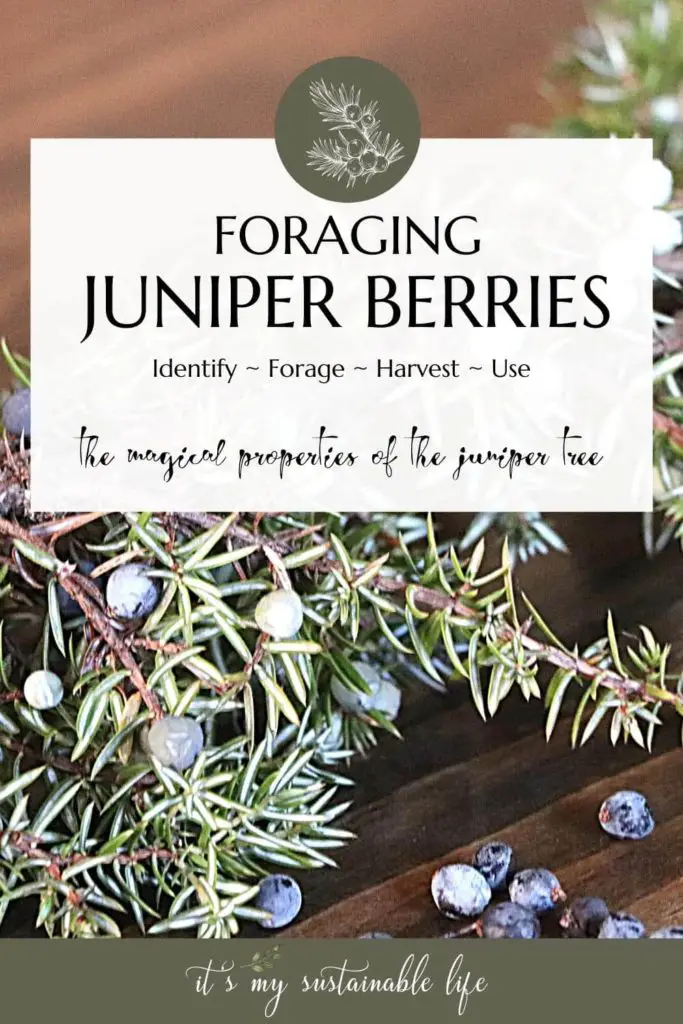
JUNIPER DEFINED
Juniper trees & shrubs (Juniperus spp.) are considered coniferous, simply meaning they are from the conifer plant group consisting of mostly evergreen trees and shrubs, as well as part of the Cupressaceae family of plants, or the cypress family.
Juniper is likely one of the most widely used evergreen options used in many a home gardens or landscape. The most common variety being the Juniperus communis L. Eastern red cedar, its name a bit misleading as its actually a juniper (Juniperus virginiana) and creeping juniper (Juniperus horizontalis) are both commonly found as well.
One variety of concern, the juniper species Savin Juniper (Juniperus sabina). It’s said this particular variety is apparently toxic when taken in large quantities.
The Northern Hemisphere boasts approximately 50 to 67 species of junipers which can vary in size and shape. Ranging from 66 to 131 feet in height all the way down to low-spreading shrubs reaching only inches to few feet off the ground.
Here in the Northeast, juniper tend to be low-lying and more shrub like. Mature junipers branches will appear knobby, taking on a wizened look, covered with thin bark that’s reddish/brown in color which looks as though it’s peeling.
Junipers evergreen leaves are typically needle or scale like, largely dependent on the variety of plant. These “leaves” tend to be prickly in nature, therefore, BEWARE when harvesting! Wear gloves and long sleeve shirts to protect your skin from their stabs.
Juniper berries are in fact not really a berry at all. They are actually a seed cone which when are produced by the female plant that will develop into a fleshy, fruit-like structure similar to a berry. The berry being comprised of scales of the seed cones that merge together. It’s these outer “scales” that will eventually (some taking up to 2 to 3 years to ripen) turn to deep blue to black in color, although some varieties are red-brown or orange. More on the “berry” can be found below.
Juniper may be one of the most aromatic evergreen plants you can find. The smell, a strong but pleasant scent, is often likened to being resinous, a bit citrusy, and sappy with bitter undertones. Above all though, the scent is powerful.
It’s this strong and powerful scent that most will be familiar with. Well, anyone who enjoys imbibing a bit of gin now and then anyway 😊
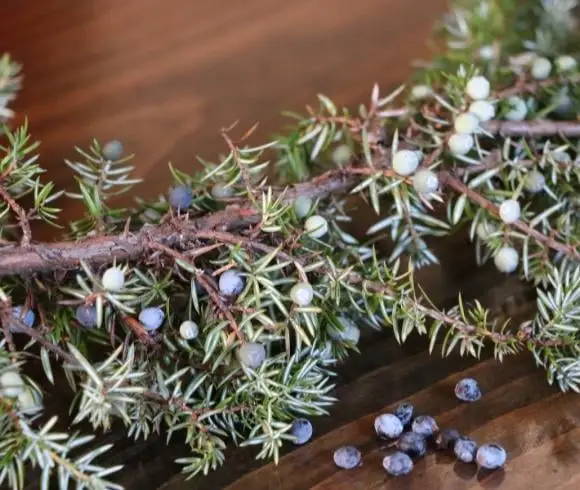
A BIT OF JUNIPER HISTORY
Juniper has deep roots in healing. So much so, Ayurvedic medicine (a holistic approach to medicine thats been around for 5000 years) still prescribes the use of juniper berry for urinary and kidney stone issues.
Juniper is the star in gin making, offering this alcohol its unique flavoring. So much so, that the word “gin” itself is derived from the Dutch* word “jenever” which translates to juniper! Although the French will dispute this bit of history I’m sure 😊
And with good reason, as the Dutch are responsible to inventing this popular drink in the 17th century. Franciscus Sylvius, a Dutch physician, is often credited with its invention.
Interestingly, his flavorful invention was sold to pharmacies and used to treat those with kidney issues, lumbago, gallstones, and stomach issues.
The English then took it and ran with it in the 18th century leading to its popularity today as one of the most requested alcoholic drinks out there.
The beauty of juniper is that its popularity does not rest alone with this distilled alcoholic drink. All properties of the juniper tree have been used throughout millennia for medicinal, culinary, and even spell casting.
Junipers aromatic properties have long been used for driving away evil spirits and disease. Folklore has suggested that when planted near doorways, witches cannot pass. That is unless they can correctly count its needles 😊
Native Americans have used junipers healing powers* to cleanse and heal infections, treat & ease arthritis symptoms, and to cure various wounds & illnesses. All parts of the juniper tree were used for antiseptic issues. Tea was made utilizing the twigs and berries which was then taken internally or applied topically to stop bleeding and heal wounds.
German settlers would ad 2-4 juniper berries to each quart of sauerkraut * made. Largely to capture juniper berries vitamin C properties.
HOW TO IDENTIFY JUNIPER BERRIES WHEN FORAGING
Fortunately juniper is very easy to identify when foraging. Using all senses, sight, smell, and touch, one can easily identify juniper berry.
WHERE TO FORAGE JUNIPER BERRIES
As juniper is not a picky grower, able to grow in poor soil conditions & tolerates dry & rocky conditions, you will likely encounter juniper in the wild rather easily.
One place you will not find juniper growing, however, is wetlands, or those areas with poor soil drainage.
HOW TO IDENTIFY JUNIPER BERRIES
The berry seed cone or scale (for ease will be referred to as berry) is easy to distinguish. On most juniper branches, one will find juniper berries in all stages of ripening. From pale grey in color to deep blue/purple.
It’s important to note that juniper berries are covered in a powdery, white substance or bloom. This bloom is actually wild yeast! Yay for anyone looking to get a ferment started!
HOW TO HARVEST JUNIPER BERRIES
As stated, when approaching juniper, take care. It’s a prickly beast and can easily give a few unwanted stabs.
Junipers evergreen scent is a powerful one. One that is not mistaken for anything other than juniper in my opinion!
The berry itself will feel a bit tacky or resinous. This is due to junipers volatile oils and beneficial resins.
HOW TO TELL WHEN JUNIPER BERRIES ARE RIPE & EDIBLE
When tasted, the berry should tout a strong taste of pine with no bitterness. The berry should taste woodsy almost with a hint of spiciness. Should it taste harshly bitter, do not consume.
It’s good to note that you would have to ingest a large quantity of unripe juniper berry for it to have ill effect!
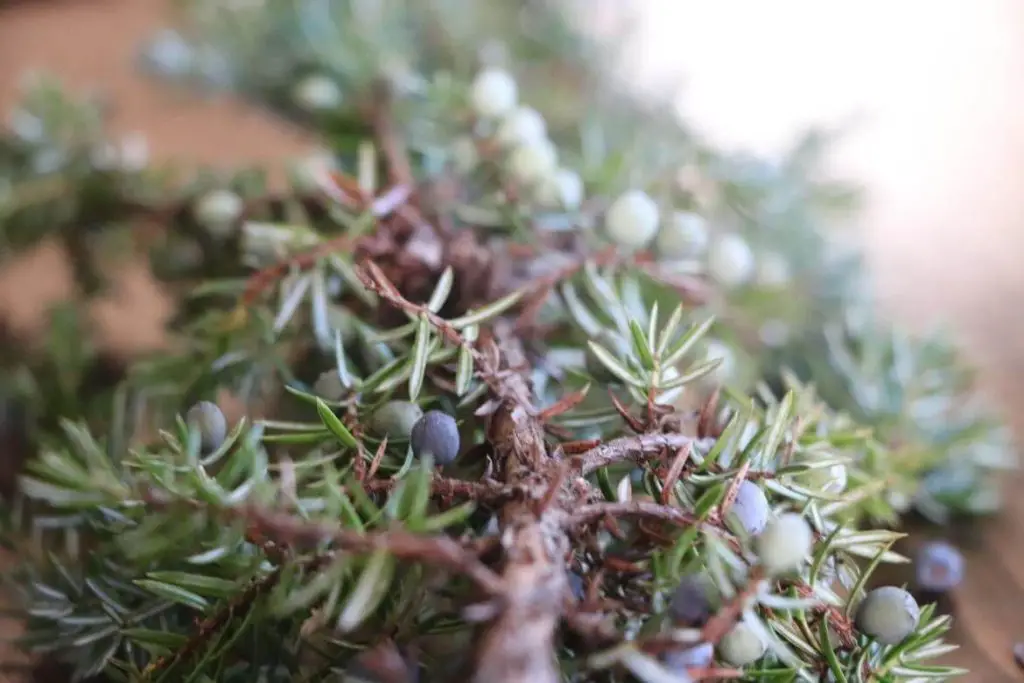
FORAGING JUNIPER BERRIES
Despite juniper trees being a bit disagreeable with their needle-like leaves, foraging juniper berries is a simple matter. It’s also an enjoyable one.
Once you’ve identified the juniper, note that the berries will tend to be in stages of ripeness. The youngest being a light grey in color to the mature, ripe berries being a deep blue.
It’s the deep blue, almost black berries that will be foraged. These ripe berries can be either picked individually by hand being careful of the sharply needled leaves or the shaking method.
The shaking method, much like harvesting mulberries, is done simply by placing a sheet or clean tarp under the tree or shrub, grasping the branches with ripe berries present, and giving it a good but gentle shake. The ripe berries will fall off the branches easily.
Go through and discard any unripe berries (those that are greenish or light grey in color), saving the ripe ones for use or drying.
FORAGING JUNIPER WOOD & LEAF
Many will utilize both the wood and leaf from juniper as well as the berry itself. More for topical antiseptic and cleansing purposes than that of internal use.
Again, our American Native ancestors would utilize juniper leaf for both pleasure and medicinally for lung and sinus infections by smoking it.
The branches and leaves would be burned to cleanse living spaces after the presence of illnesses, in essence smudging with juniper.
Juniper wood is extremely flexible, making this the traditional choice of wood to use when making hunting bows in the Great Basin* region.
To harvest juniper wood and leaf, simply snip off twigs (wood) and leaves, always being mindful of selective pruning, taking only what you need and leaving the rest.
DRYING JUNIPER BERRIES, WOOD, AND LEAF
Once you have your juniper harvested, drying it is a simple matter. To dry, hang or lay out your plant material in a well ventilated, cool area out of direct sunlight.
Expect it to take the berries anywhere between 2-4 weeks time to completely dry depending on your humidity levels.
Yes, I said cool area. Heat and light are not juniper’s friend.
Heat and light may damage juniper’s aromatic properties, thus negatively effecting any flavor or medicinal properties it may possess.
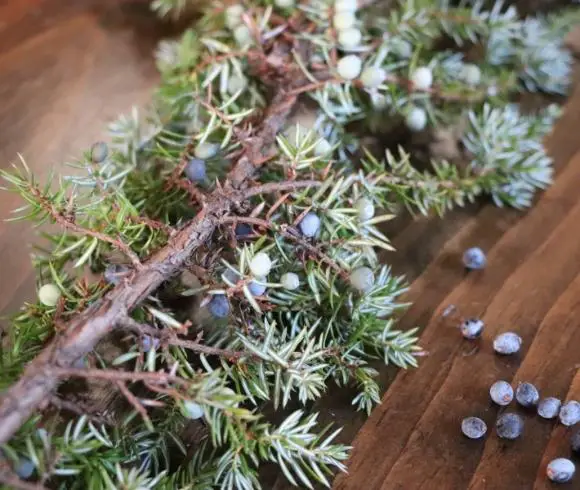
JUNIPER BERRY USES
Juniper berry uses go far beyond that of making gin. This aromatic berry is utilized both medicinally & in our culinary world.
JUNIPER BERRY CULINARY USES
Fortunately for us, juniper berries use in the culinary world go beyond that of making gin.
Did you know that you can make your own gin by infusing the berries along with other herbs & spices for a few days in a neutral alcohol! Homemade alcohol recipes are a wonderful idea for Holiday gift giving!

Juniper berries are said to stimulate the appetite. Because of such, they make for a great addition to appetizers, especially those with exotic or strongly flavored meats.
Although juniper berry is used in a wide variety of game meat dishes (think venison, hare, goose, quail, veal, pheasant etc), it’s also commonly used when making desserts, stews, sauces, and marinades.
A few branches of juniper added to an outdoor grill will enhance both grilled meat or fish alike with its smokey flavors.
As a general rule of thumb, juniper berries pair nicely with parsley, fennel, bay leaf, and garlic.
Need more culinary inspiration? Here are a few idea’s …
- INFUSED VINEGAR
- SAUSAGE
- JUNIPER ASH *
- JUNIPER TEA/INFUSION – Lightly crush about a teaspoon of dried juniper berries, placing them in a mug along with boiling water (about 1 cup). Cover and allow to steep for a minimum of 20-30 minutes.
JUNIPER BERRY CAUTIONS
As with any herbal protocol, one should consult with their physician when in doubt and research fully prior to beginning.
TOXICITY: Juniper in any form including essential oils should not be used by pregnant women or those with kidney issues. Possible allergic reactions may occur in some and may interact negatively with certain medications, an extensive list of pharmaceuticals can be found HERE. Those with diabetes should avoid juniper products.
ICYMI, my disclaimer is here …
DISCLAIMER
Recommendations and or suggestions made by this blog regarding husbandry and or herbal remedies etc. are not meant to replace solid advice from qualified professionals. None of the information on this blog has been evaluated by the FDA. Products or remedies mentioned are not intended to diagnose, treat, cure or prevent disease. Please do your due diligence. Research, talk to qualified professionals and proceed at your own risk.
Juniper taken medicinally should be taken short-term and in moderation only.
JUNIPER BERRY MEDICINAL USES
Juniper really shines when it comes to treating ailments. The juniper berry has certainly earned its keep over time in our home apothecaries.
Should you not have access to foraging your own juniper berries, you can purchase your own from Mountain Rose Herbs.
Juniper’s volatile oils are not only what contribute to its strong scent (principally pinene) & flavor, but are largely what contribute to its medicinal value.
When used for its medicinal properties, juniper can be taken internally, inhaled (smoked, needles and twigs can be burned to create an incense) and applied topically (salves & balms).
An effective diuretic, juniper also boasts antiseptic and antiviral properties in addition to …
“Juniper berries or extract of the plant has traditionally been used as diuretic, anti-arthritis, anti-diabetes, antiseptic as well as for the treatment of gastrointestinal and autoimmune disorders.”
NCBI
JUNIPER BERRIES FOR URINARY TRACT INFECTIONS
When I was younger I suffered from UTI’s often. I can certainly speak from experience here, they can be painful. Fortunately, juniper berries diuretic, antiseptic, and antiviral properties make them a great choice for treatment.
Juniper berries are extremely supporting in maintaining urinary tract health. Should you feel a UTI coming on (you’ll recognize it after experiencing it once) don’t delay. Begin treatment as soon as possible.
Juniper tea by itself or with other supporting herbs (think uva ursi or chaparral here) or juniper tincture (recipe below) are both recommended.
JUNIPER BERRIES FOR STRESS RELIEF
Junipers volatile oil is what create’s its amazing aromatherapy. Studies are now being conducted on aromatherapeutic treatment with juniper to relieve anxiety, nervous tension, and other stress related issues.
Known throughout time for junipers ability to clear the mind, utilizing juniper either in smoke form or essential oil may be of help during high stress.
JUNIPER FOR SKIN ISSUES
The essential oil of juniper, cade oil (made with the wood of juniper) or an infused oil (recipe below) of juniper may aid with skin issues such as acne, eczema, psoriasis, skin growths & athlete’s foot.
In addition, rubbing the juniper infused oil into the skin may aid with joint and muscle pain.
JUNIPER AS AN ANTI-INFLAMMATORY
Juniper boasts anti-inflammatory properties (largely from juniper oil’s high concentrated levels of monoterpenes), making it an excellent choice for those dealing with arthritis and other diseases/issue’s stemming from inflammation in the body *.
JUNIPER AS A DIURETIC
As we’ve discussed, juniper has long been used for urinary type issue’s. Its diuretic properties may aid in flushing out the system when it’s on salt overload as well.
JUNIPER EASES GASTROINTESTINAL ISSUES
Juniper has been reported to ease digestive issues (flatulence, bloating) due to its carminative, anti-spasmodic, and anti-bacterial actions *. In addition, juniper leaf extract may alleviate and enhance healing of ulcers *.
When you’re feeling as though you’ve overdone it with a large meal, sipping a bit of juniper tea (maybe with the addition of some fresh ginger) may offer relief.
JUNIPER RELIEVES CONGESTION
Congestion issues stemming from seasonal colds and viruses may be relieved from utilizing juniper tea or tincture. Add a bit of thyme to that tea, and you have a wonderful home remedy ready for the taking.
JUNIPER INFUSED OIL
As you may already be aware, here on the hill we love our infused oils. Lavender, Rose, Dandelion, and Calendula are just some of our favorites. You can now add juniper infused oil to that list 😊
An infused oil is a favorite way to capture all the medicinal and beneficial properties a plant has to offer. It’s then either used directly through massage or made into beneficial salves and balms.
To make and easy juniper infused oil, simply follow the instructions below.
INGREDIENTS
- 1 Cup dried juniper berries
- 1.25 Cup Organic EVOO
DIRECTIONS
- Slightly crush the dried juniper berries in a pestle and mortar and cover with the organic EVOO
- Place the mixture into a double boiler and cover with a loose fitting lid
- On medium to low heat (water does not want to reach boiling point) gently heat for 4-5 hours
- Strain the infused oil through a fine mesh strainer, nutbag, cheesecloth or muslin
- Store in a sealed jar in a cool, dark cupboard until ready to use, always being sure to label and date your end product
Alternatively, you could easily substitute the double boiler for a crockpot and keep on low setting for the 4-5 hours.
JUNIPER BERRY TINCTURE RECIPE
To make your own juniper berry tincture follow the recipe instructions here …
INGREDIENTS & EQUIPMENT
- Dried juniper berries
- 80 proof (or higher) alcohol
- Mason jar
- Sieve
- Cheesecloth or fine mesh strainer
- Funnel
DIRECTIONS
- Measure your dried juniper berries and alcohol; a 1:5 ratio
- Crush the berries with a pestle and mortar
- Place crushed berries and alcohol into a mason jar with lid
- Store in a cool, dark cupboard, shaking every few days to mix well for at least 6 weeks or more
- Strain the plant material from the tincture through cheesecloth or fine mesh strainer
- Funnel the tincture into a dark amber glass jar, preferably with a dropper top, label and store in a cool dark cupboard indefinitely
Hopefully you will be able to take a stroll and forage juniper berries this winter and make yourself some tea, oil or tincture! It’s easy, enjoyable, and may just relieve a few issue’s in the process 😊
What will you be making and using with your foraged juniper berries?
Love, Light, & Laughter ~

Enjoy this article? Please consider sharing it on your favorite social media channel! Want more? Subscribe below for the occasional update with all the “happenings on the hill”!

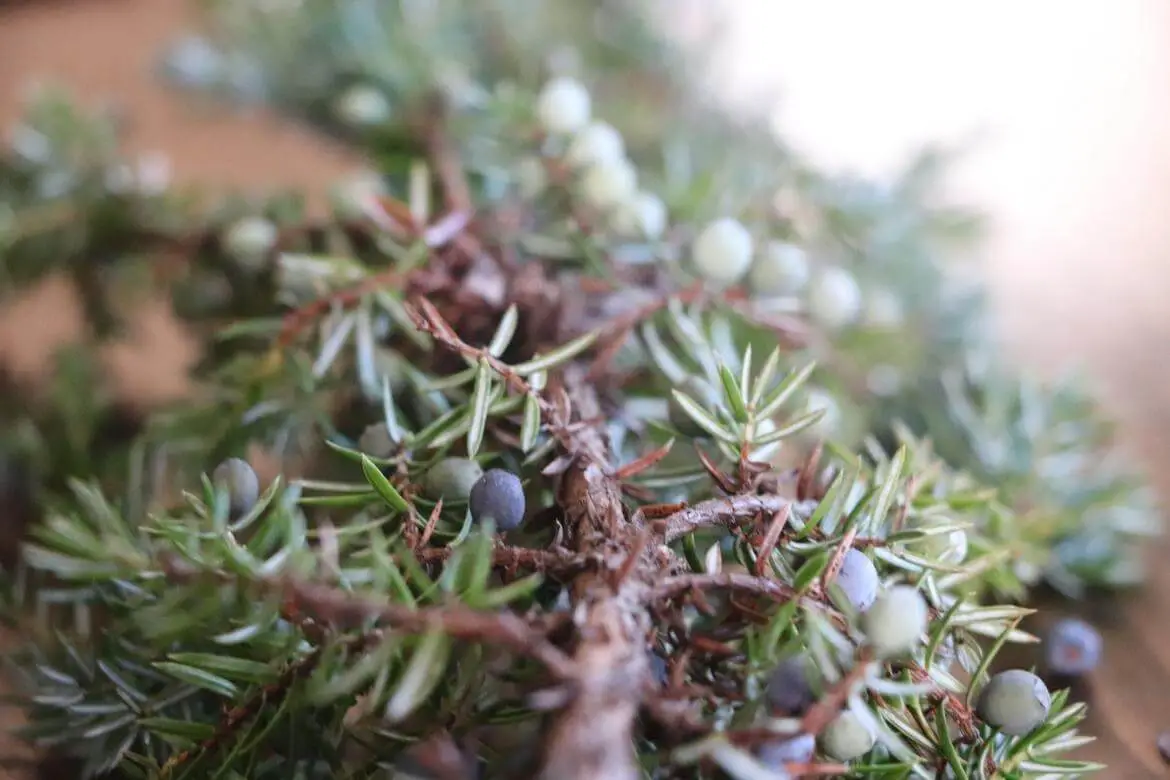

2 comments
Thanks so much for sharing this at the Homestead Blog Hop!
We don’t get junipers down South here, but harvesting the berries sounds like a fun experience. I’ve always enjoyed the scent!
Have a great week!
Laurie
You can still take advantage of juniper berries by ordering them! Hope you can give them a try.